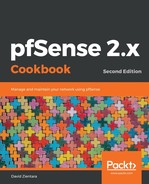In any deployment scenario, it is likely you will be using your pfSense system to filter traffic—after all, filtering traffic is the core function of a firewall. In order to do so, you will find it necessary to create and edit firewall rules. pfSense supports the creation of two types of firewall rules. Standard firewall rules work on a per-interface basis and filter traffic leaving the interface. Floating rules, on the other hand, can be applied to more than one interface, and can apply to traffic both entering and leaving the interface.
Network Address Translation (NAT) is useful in scenarios in which we have a fixed number of external IP addresses and a series of internal addresses. This is often the case in home and SOHO deployments, and, as a result, we will cover them in this chapter. Finally, in some cases, it is useful to automate NAT port mapping, and to this end, we will cover UPnP and NAT-PnP.
